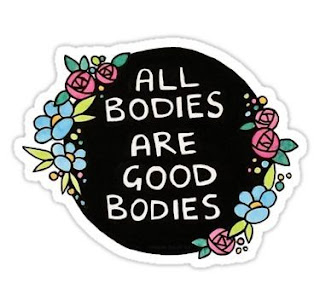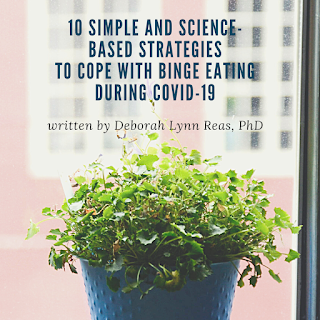Behind Beauty Standards and Their Effects on Women - Camille Richard
When I was in high school, I struggled with an eating
disorder. Since
then, I have developed a passion for understanding the psychology behind beauty
standards and their effects on women. I have encountered many different people
but their struggles all have common themes, there is indeed a correlation
between what we are shown in the
media and how we perceive ourselves.
One
of the things that truly helped me recover was when I discovered Body Positivity, a social movement that
is meant to dismantle fatphobia and help people living in marginalized bodies
to be more represented. Another thing that helped me was to learn more about intuitive eating, its first principle
being to reject the diet mentality. It is crucial to understand that a
"healthy" weight is not a universal number or size. Through the
years, I gained more knowledge of what diet
culture is, how prevalent it is in society and how harmful it can be.
Mental
illnesses are on the rise: there’s undeniably a silent epidemic of mental
illness among teenagers. (Friedman 2006) In fact, eating disorders have the
highest mortality rate of any mental illnesses. (NEDIC 2019) One of the leading
causes of eating disorders is the media since the image of womens’ body that
are portrayed can intice them to want to be thin. This pressure can develop
into an eating disorder, because of the internalization of thin-ideal, the
objectification and the appearance schematicity (someone who believes that
appearance is a key factor in one’s life).
To
begin with, body dissatisfaction is a major factor in eating disorders and can
occur by the internalization of the thin-ideal that is presented across the
media in television programs and magazines. (Harrison and Fredrickson 2003) In
fact, the rise in eating disorders is happening at the same time as the number
of articles and advertisements promoting weight-loss diets in women’s magazines
increases. (Stice et al., 1994) Eating disorders have risen steadily over the
past 30 years. Furthermore, in the 1920s and 1980s, there was an epidemic of
disordered eating pathology, two eras in which the “ideal woman” was at her
thinnest in the U.S. history and where females’ bodies were slim and this was
equal to beauty. (Cantor and Harrison 1997) Womens’ images presented in the
media are thinner than the average women. We can see across movies, magazines
and television programs that thin television characters are over-represented
and thinness is consistently emphasized and rewarded for women. (Grabe, Hyde
and Ward 2008)
A
shocking number of women nowadays struggle with eating disorders. (Cantor and
Harrison 1997) Girls are starting to diet younger than ever before and children
as young as 7 years old can start being dissatisfied with their bodies. This
problem touches women of different body size and race and 1 out of 10 will
eventually develop an eating disorder. (Canadian Women’s Health Network ;
Grabe, Hyde and Ward 2008)
In
addition, recurrent presentation of thin and attractive women that will usually
be combined with beauty and success, can affect viewers to have unrealistic
expectations of what a women should look like. (Hargreaves and Tiggemann 2003)
Exposure to slides of thin women in a study showed that their self-esteem and
weight satisfaction went down compared to exposure to average or “heavy”
models. (Stice et al., 1994) As our personal body size diverges from the
stereotype that society expects us to look like, self-satisfaction decreases.
(Gardner et al., 1980)
Self-objectification
is the tendency to perceive and describe one’s body according only to how it
appears, women nowadays strive for a false ideal presented by the media that
can later result in disordered eating behaviours. When women’s bodies appear in
sports media, the accent is put more on what the body can do rather than how it
appears, therefore the outcome is positive and the perception of their body is
healthy. People who tend to self-objectify tend to define themselves by their
physical attributes instead of non-observable qualities. They base their
self-worth on what people perceive of them. (Harrison and Fredrickson, 2003)
Eating disorders are not the only major risk factors when self-objectification
occurs, so are depression and body shame.
Also,
media tends to show women with “perfect” bodies, which contributes to
self-objectification in girls and women. The models have their bodies always
distorted, with the practice of ‘airbrushing’ photographs, making their skin
lighter or their waist smaller, for example. To look like actors on television,
the viewers may also eat less; as women actors aren’t shown eating on a regular
basis compared to men. Slim body shape standards in television is more present
for women than for men. In the pageant world, participants’ weight decreased
significantly every year, and the winners are, most of the time, thinner than
the others. When female adolescents are exposed to beauty advertisements rather
than neutral ads, they develop high standards towards sex appeal and beauty.
(Cantor and Harrison, 1997) Media through the fashion ideals that are shown
across movies, magazines and television programs, lead to believe that weight
control is equal to self-control and will lead to beauty and success. (Gardner
et al., 1980)
Women
are taught to internalize people’s perspective of them as the way they see
themselves. They self-evaluate and compare themselves to the social body image
that is portrayed by media. The unrealistic beauty standard that is presented
throughout the media leads not only women and girls, but also men and boys to
have unrealistic expectations. (Hargreaves and Tiggemann 2003 ; Harrison and
Fredrickson 2003) Furthermore, it was shown that people with anorexia nervosa
(AN) tend to highly endorse gender roles. (Murnen and Smolak, 1997) Over the
past 20 to 30 years, the definition of gender roles, particularly for females,
has changed dramatically. High school girls describe the “ideal” woman as a
“superwoman”, which means being feminine and masculine at the same time ;
taking care of others, while being attractive, have a career, money and
confidence. It was proven that the girls who endorsed this ideal are more at
risk to develop an eating disorder. (Murnen and Smolak, 1997) These women are
perfectionists, they want to “have it all”. And when they are over overwhelmed
by it, that’s when the “superwoman complex” happens and disordered eating
pathology manifests itself. (Mensinger et al., 2007)
In
conclusion, women are not only directly pressured by the media to be thin, but
also through the expectations of others that have been exposed to these
messages. Gender-role endorsement is also encouraged, and this creates a social
environment of ideal-body stereotype internalization, which is associated with
body dissatisfaction and disordered eating symptoms. (Stice et al., 1994 ;
Cantor and Harrison 1997) Raising awareness around media literacy is important,
as well as pressuring brands to ban Photoshop, and encourage TV shows to cast a
wider range of body types.



Comments
Post a Comment